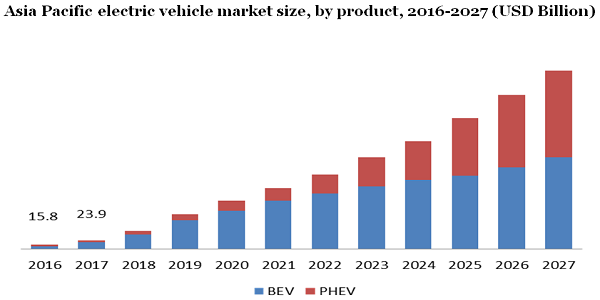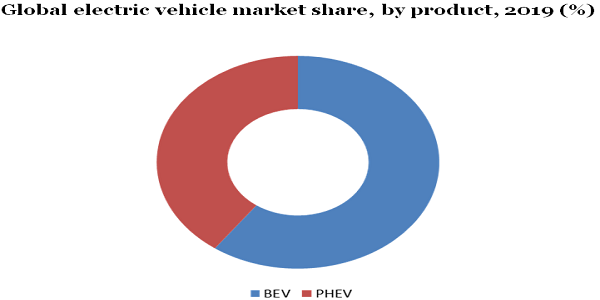- US: +1-408-610-2300
- Toll Free: +1-866-831-4085
- Become a Client
The global electric vehicle market size was expected worth 2,373.5 thousand units in the year 2019. It is anticipated to register a CAGR of 41.5% from 2020 to 2027. Favorable initiatives by governments across the globe have promoted the manufacturing of EVs. For example, in 2019, the auto manufacturers and the government of Germany agreed to increase cash incentives under the plan named, “Environment Bonus” for battery-operated cars. The cash incentives will touch USD 6,680 for every vehicle and will reduce the cost by half for the auto industry. Moreover, the government aims to mandate incentives by 2025. The Indian government also announced its initiative with an expenditure of USD 1.4 billion to subsidize sales of electric and hybrid vehicles by 2022. These incentives are only applicable to vehicles costing lower than USD 21,177, thus, leading to surging demand for electric vehicles over the forecast period.

Strict regulations for vehicle emissions have resulted in fueling the demand for EVs. For example, the EU set a goal of net-zero greenhouse gas effluents by 2050. Electric vehicles emit lesser effluents than traditional vehicles. Therefore, governments across the globe are promoting the use of electronic vehicles to lower oil consumption, related emission, and air pollution.
Higher investments in EVs are viewed as a key driver for this market. Key players like Ford Motor Company, Groupe Renault, and Daimler AG are investing extensively to manufacture these vehicles. Daimler AG December 2018 announced its investments at USD 20.0 billion in the procurement of battery cells for EVs. The company focuses on electrifying its portfolio of Mercedes Benz by 2022 with approximately 130 EVs. Ford Motor Company also announced its target of manufacturing 40 EVs by 2022 with an investment worth USD 11.0 billion.
Limitations in charging infrastructure are viewed as a hindrance to market growth in the upcoming years. Lack of standardization and variations in the charging load is among the major weaknesses of the market. Various countries adhere to their own standards like CHAdeMO (Japan), GB/T (China), and CCS (Europe, Korea, and the U.S.). Manufacturers like Tesla, Inc., emphasize combating the drawbacks by establishing a personal charging network.
The rising preference for electric vehicles in government, as well as the commercial sector, is expected to boost the electric vehicle (EV) market. The “Department for Transport”, U.K., in 2020, invested approximately USD 65 million for the overall electric bus town. The department of transport projected that about 7400 tons of CO2 emission can be saved by 200 electric buses, which is of vital importance to lower down the carbon emissions. Moreover, the partnership announced between Uber and Nissan, in 2002, for the production of 2000 electric vehicles for Uber drivers in London is aimed at making all the vehicles emission-free by the year 2025.
The PHEV segment held a market share of over 30.0% in 2019 based on revenue. On the other hand, the BEV segment is anticipated to register a CAGR of more than 25.0% over the forecast period. The growth can be attributed to the rising environmental concerns and the benefits provided by BEV among consumers.

The PHEV segment is expected to witness the highest CAGR exceeding 45.0% based on revenue from 2020 to 2027. The growth is imputed by the various government initiatives in countries like China and India to promote the adoption of electric vehicles. Additionally, companies like Volkswagen Group aim at increasing the sales of plug-in electric cars by 60% till 202o as compared to 2018.
North America held a significant share of more than 15.0% based on revenue. The growth is attributed to the rising demand for EVs in the U.S. market. Moreover, various initiatives are taken by policymakers, automotive manufacturers, charging network companies, and non-profit organizations. The NPO was named “Veloz” which focuses on attracting innovation, investments, growth of EVs, and marketing in North America. Additionally, Electrify America, in 2018, announced its investment plans worth USD 200.00 million for California. Therefore, the demand for EVs is likely to rise in North America by 2027.
The Asia Pacific is expected to emerge as a lucrative market over the forecast period due to the fueling demand for electric cars in Japan, India, and China. The number of electric cars on the road in China increased to 45.0% in 2018 from 39.0% in 2017. Volkswagen Group, in 2018, announced its goal to manufacture 22 million electric vehicles by 2026, a majority of which is to be produced in China. Further, Tesla, Inc. aims to manufacture over 150 thousand 3s Model cars in China. Similarly, the Indian government also announced tax incentives like income tax deductions on electric vehicles to promote its purchases.
The market is characterized and consolidated by high competition due to the existence of eminent players like Tesla, Inc.; Volkswagen Group; Daimler AG; Groupe Renault, and Toyota Motor Corporation. These companies invest heavily in R&D to manufacture innovative and advance electric vehicles and strengthen their portfolio. For example, Volkswagen Group, in November 2019, announced an investment of over USD 4.0 billion in 2020, in China. Over 40% of this spending is done in e-mobility.
Various companies focus on strategies like mergers & acquisitions, strategic partnerships, and regional expansion to exhibit a competitive edge in the market. For example, Tesla, Inc., in March 2019, announced the acquisition of Maxwell Technologies, Inc. to lower the overall cost and provide better batteries for Tesla. Moreover, BYD Company Ltd and Toyota Motor Corporation in November 2019 announced their joint venture for R&D of BEV. As per the contract, the new company will be situated in China and will engage in the development and design of BEVs and other parts.
|
Attribute |
Details |
|
The base year for estimation |
2019 |
|
Actual estimates/Historical data |
2016 - 2018 |
|
Forecast period |
2020 - 2027 |
|
Market representation |
Revenue in USD Billion, Volume in Thousand Units, and CAGR from 2020 to 2027 |
|
Regional scope |
North America, Europe, Asia Pacific, Latin America, and Middle East & Africa |
|
Country Scope |
U.S., Canada, U.K., Germany, France, Norway, Netherlands, Sweden, China, India, Japan, Korea, Brazil, Mexico |
|
Report coverage |
Revenue forecast, company share, competitive landscape, and growth factors and trends |
|
15% free customization scope (equivalent to 5 analyst working days) |
If you need specific information, which is not currently within the scope of the report, we will provide it to you as a part of the customization |
This report forecasts revenue growth at global, regional, and country levels and provides an analysis of the latest industry trends in each of the sub-segments from 2016 to 2027. For the purpose of this study, Million Insights has segmented the global electric vehicle market report based on product and region:
• Product Outlook (Volume, Thousand Units; Revenue, USD Billion, 2016 - 2027)
• Battery Electric Vehicles (BEV)
• Plug-in Hybrid Electric Vehicles (PHEV)
• Regional Outlook (Volume, Thousand Units; Revenue, USD Billion, 2016 - 2027)
• North America
• U.S.
• Canada
• Europe
• U.K.
• Germany
• France
• Norway
• Netherlands
• Sweden
• the Asia Pacific
• China
• India
• Japan
• Korea
• Latin America
• Brazil
• Mexico
• Middle East & Africa


Research Support Specialist, USA